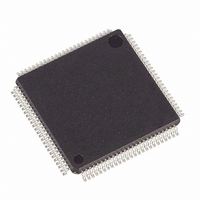DS2155LN+ Maxim Integrated Products, DS2155LN+ Datasheet - Page 51

DS2155LN+
Manufacturer Part Number
DS2155LN+
Description
IC TXRX T1/E1/J1 1-CHIP 100-LQFP
Manufacturer
Maxim Integrated Products
Datasheet
1.DS2155L.pdf
(238 pages)
Specifications of DS2155LN+
Function
Single-Chip Transceiver
Interface
E1, HDLC, J1, T1
Number Of Circuits
1
Voltage - Supply
3.14 V ~ 3.47 V
Current - Supply
75mA
Operating Temperature
-40°C ~ 85°C
Mounting Type
Surface Mount
Package / Case
100-LQFP
Includes
BERT Generator and Detector, CMI Coder and Decoder, HDLC Controller
Product
Framer
Number Of Transceivers
1
Data Rate
64 Kbps
Supply Voltage (max)
3.465 V
Supply Voltage (min)
3.135 V
Supply Current (max)
75 mA (Typ)
Maximum Operating Temperature
+ 85 C
Minimum Operating Temperature
- 40 C
Mounting Style
SMD/SMT
Lead Free Status / RoHS Status
Lead free / RoHS Compliant
Power (watts)
-
Lead Free Status / Rohs Status
Lead free / RoHS Compliant
- Current page: 51 of 238
- Download datasheet (2Mb)
DS2155
9.2 T1 Transmit Transparency
The software signaling insertion-enable registers, SSIE1–SSIE4, can be used to select signaling insertion
from the transmit signaling registers, TS1–TS12, on a per-channel basis. Setting a bit in the SSIEx
register allows signaling data to be sourced from the signaling registers for that channel.
In transparent mode, bit 7 stuffing and/or robbed-bit signaling is prevented from overwriting the data in
the channels. If a DS0 is programmed to be clear, no robbed-bit signaling is inserted nor does the channel
have bit 7 stuffing performed. However, in the D4 framing mode, bit 2 is overwritten by a 0 when a
Yellow Alarm is transmitted. Also, the user has the option to globally override the SSIEx registers from
determining which channels are to have bit 7 stuffing performed. If the T1TCR1.3 and T1TCR2.0 bits are
set to 1, then all 24 T1 channels have bit 7 stuffing performed on them, regardless of how the SSIEx
registers are programmed. In this manner, the SSIEx registers are only affecting the channels that are to
have robbed-bit signaling inserted into them.
9.3 AIS-CI and RAI-CI Generation and Detection
The DS2155 can transmit and detect the RAI-CI and AIS-CI codes in T1 mode. These codes are
compatible with and do not interfere with the standard RAI (Yellow) and AIS (Blue) alarms. These codes
are defined in ANSI T1.403.
The AIS-CI code (alarm indication signal-customer installation) is the same for both ESF and D4
operation. Setting the TAIS-CI bit in the T1CCR1 register and the TBL bit in the T1TCR1 register causes
the DS2155 to transmit the AIS-CI code. The RAIS-CI status bit in the SR4 register indicates the
reception of an AIS-CI signal.
The RAI-CI (remote alarm indication-customer installation) code for T1 ESF operation is a special form
of the ESF Yellow Alarm (an unscheduled message). Setting the RAIS-CI bit in the T1CCR1 register
causes the DS2155 to transmit the RAI-CI code. The RAI-CI code causes a standard Yellow Alarm to be
detected by the receiver. When the host processor detects a Yellow Alarm, it can then test the alarm for
the RAI-CI state by checking the BOC detector for the RAI-CI flag. That flag is a 011111 code in the 6-
bit BOC message.
The RAI-CI code for T1 D4 operation is a 10001011 flag in all 24 time slots. To transmit the RAI-CI
code the host sets all 24 channels to idle with a 10001011 idle code. Since this code meets the
requirements for a standard T1 D4 Yellow Alarm, the host can use the receive channel monitor function
to detect the 100001011 code whenever a standard Yellow Alarm is detected.
51 of 238
Related parts for DS2155LN+
Image
Part Number
Description
Manufacturer
Datasheet
Request
R

Part Number:
Description:
Manufacturer:
Maxim Integrated Products
Datasheet:

Part Number:
Description:
Ds2155 T1/e1/j1 Single-chip Transceiver
Manufacturer:
Maxim Integrated Products, Inc.
Datasheet:

Part Number:
Description:
MAX7528KCWPMaxim Integrated Products [CMOS Dual 8-Bit Buffered Multiplying DACs]
Manufacturer:
Maxim Integrated Products
Datasheet:

Part Number:
Description:
Single +5V, fully integrated, 1.25Gbps laser diode driver.
Manufacturer:
Maxim Integrated Products
Datasheet:

Part Number:
Description:
Single +5V, fully integrated, 155Mbps laser diode driver.
Manufacturer:
Maxim Integrated Products
Datasheet:

Part Number:
Description:
VRD11/VRD10, K8 Rev F 2/3/4-Phase PWM Controllers with Integrated Dual MOSFET Drivers
Manufacturer:
Maxim Integrated Products
Datasheet:

Part Number:
Description:
Highly Integrated Level 2 SMBus Battery Chargers
Manufacturer:
Maxim Integrated Products
Datasheet:

Part Number:
Description:
Current Monitor and Accumulator with Integrated Sense Resistor; ; Temperature Range: -40°C to +85°C
Manufacturer:
Maxim Integrated Products

Part Number:
Description:
TSSOP 14/A°/RS-485 Transceivers with Integrated 100O/120O Termination Resis
Manufacturer:
Maxim Integrated Products

Part Number:
Description:
TSSOP 14/A°/RS-485 Transceivers with Integrated 100O/120O Termination Resis
Manufacturer:
Maxim Integrated Products

Part Number:
Description:
QFN 16/A°/AC-DC and DC-DC Peak-Current-Mode Converters with Integrated Step
Manufacturer:
Maxim Integrated Products

Part Number:
Description:
TDFN/A/65V, 1A, 600KHZ, SYNCHRONOUS STEP-DOWN REGULATOR WITH INTEGRATED SWI
Manufacturer:
Maxim Integrated Products

Part Number:
Description:
Integrated Temperature Controller f
Manufacturer:
Maxim Integrated Products

Part Number:
Description:
SOT23-6/I°/45MHz to 650MHz, Integrated IF VCOs with Differential Output
Manufacturer:
Maxim Integrated Products

Part Number:
Description:
SOT23-6/I°/45MHz to 650MHz, Integrated IF VCOs with Differential Output
Manufacturer:
Maxim Integrated Products










